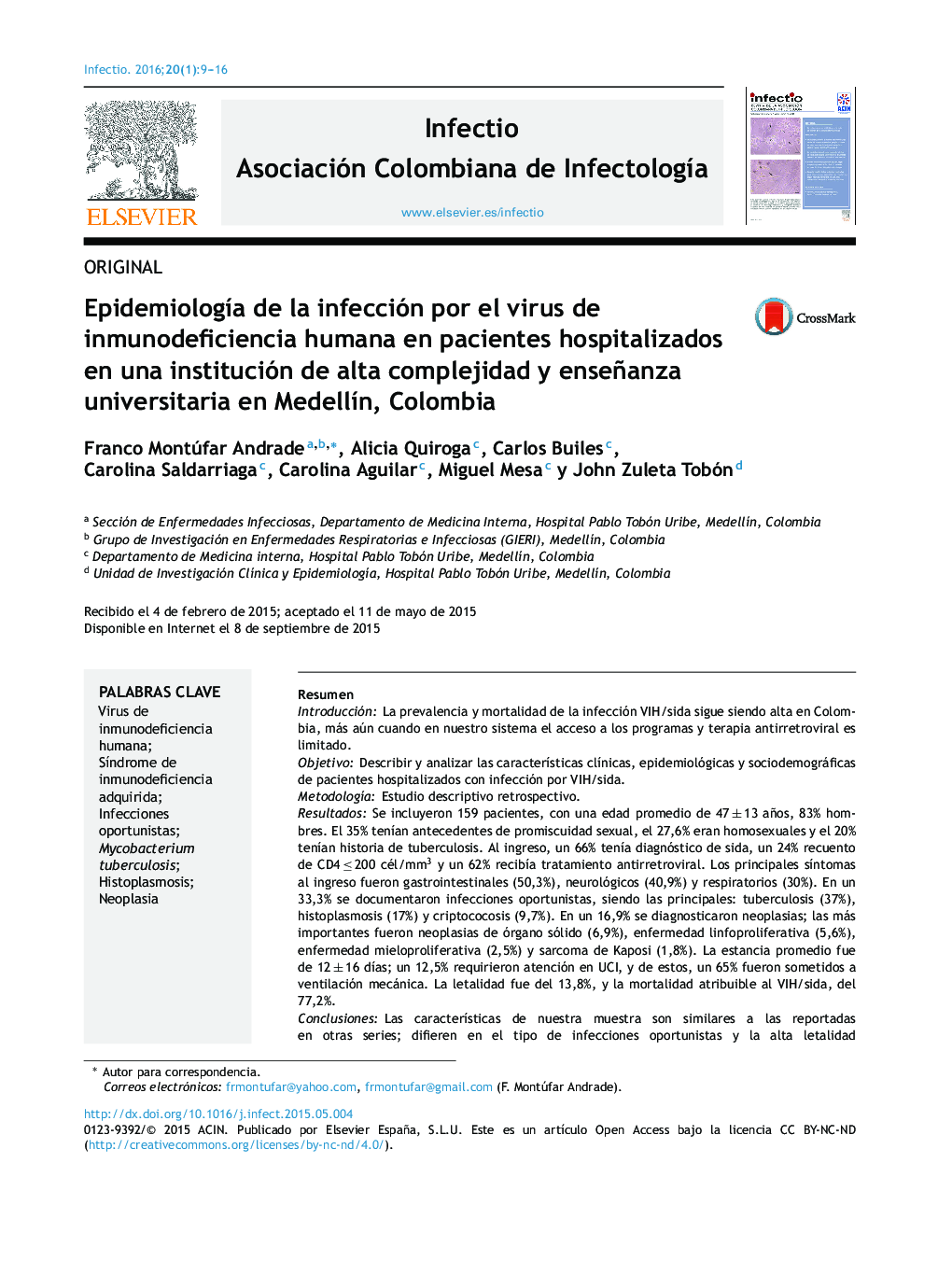| Article ID | Journal | Published Year | Pages | File Type |
|---|---|---|---|---|
| 3403632 | Infectio | 2016 | 8 Pages |
ResumenIntroducciónLa prevalencia y mortalidad de la infección VIH/sida sigue siendo alta en Colombia, más aún cuando en nuestro sistema el acceso a los programas y terapia antirretroviral es limitado.ObjetivoDescribir y analizar las características clínicas, epidemiológicas y sociodemográficas de pacientes hospitalizados con infección por VIH/sida.MetodologíaEstudio descriptivo retrospectivo.ResultadosSe incluyeron 159 pacientes, con una edad promedio de 47 ± 13 años, 83% hombres. El 35% tenían antecedentes de promiscuidad sexual, el 27,6% eran homosexuales y el 20% tenían historia de tuberculosis. Al ingreso, un 66% tenía diagnóstico de sida, un 24% recuento de CD4 ≤ 200 cél/mm3 y un 62% recibía tratamiento antirretroviral. Los principales síntomas al ingreso fueron gastrointestinales (50,3%), neurológicos (40,9%) y respiratorios (30%). En un 33,3% se documentaron infecciones oportunistas, siendo las principales: tuberculosis (37%), histoplasmosis (17%) y criptococosis (9,7%). En un 16,9% se diagnosticaron neoplasias; las más importantes fueron neoplasias de órgano sólido (6,9%), enfermedad linfoproliferativa (5,6%), enfermedad mieloproliferativa (2,5%) y sarcoma de Kaposi (1,8%). La estancia promedio fue de 12 ± 16 días; un 12,5% requirieron atención en UCI, y de estos, un 65% fueron sometidos a ventilación mecánica. La letalidad fue del 13,8%, y la mortalidad atribuible al VIH/sida, del 77,2%.ConclusionesLas características de nuestra muestra son similares a las reportadas en otras series; difieren en el tipo de infecciones oportunistas y la alta letalidad y mortalidad atribuible a la infección VIH/sida. Las principales causas de hospitalización son infecciones oportunistas, seguidas de enfermedad neoplásica y quirúrgica. Mycobacterium tuberculosis es la infección oportunista más frecuente.
IntroductionThe prevalence and mortality of HIV/AIDS infection still high in Colombia, due to a lack of access to HIV programmes and the limited coverage of antiretroviral therapy.ObjectiveTo describe and analyse clinical, epidemiological and socio-demographic features of inpatients with HIV/AIDS infection.MethodologyDescriptive retrospective study.ResultsA total of 159 patients were included; the average age was 47 ± 13 years and 83% were men. 35% had a history of sexual promiscuity, 27.6% were men who had sex with men and 20% had a history of tuberculosis. At admission, 66.6% had AIDS, 24% had CD4 ≤ 200 cells/mm3 and 62% were taking antiretroviral therapy. The most common symptoms at admission were gastrointestinal (50.3%), neurological (40.9%) and respiratory (30%). In 33.3%, opportunistic infections were documented and the most frequent were: tuberculosis (37%), histoplasmosis (17%) and cryptococcosis (9.7%). Some 16.9% of patients had cancer, including 6.91% with a solid organ neoplasm, lymphoproliferative disease (5.6%), myeloproliferative disease (2.5%) and Kaposi's sarcoma (1.8%). The average length of hospitalisation was 12 ± 16 days; some 12.5% required ICU care and 65% required mechanical ventilation. Lethality was 13.8% and attributable mortality to HIV/AIDS infection was 77.2%.ConclusionsThe characteristics of our population are similar to those described in other studies; however a high lethality and attributable mortality to HIV/AIDS infection were found. The most frequent causes of hospitalisation were opportunistic infections followed by neoplasms. Mycobacterium tuberculosis was the most common opportunistic infection.
